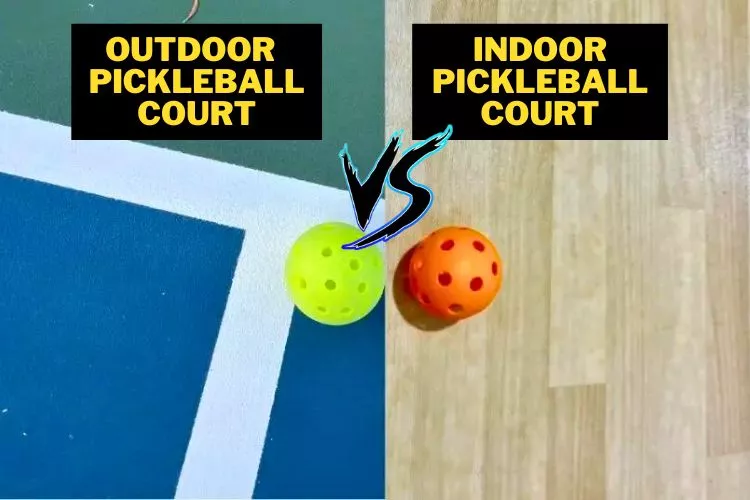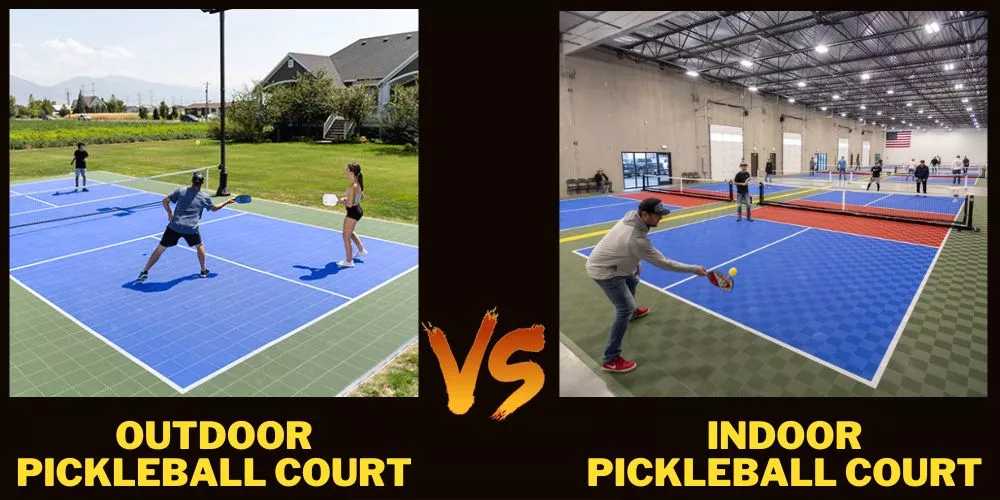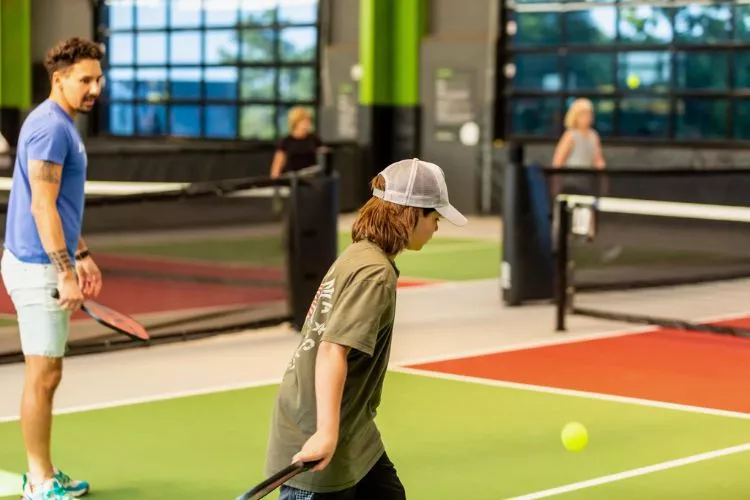Pickleball, a sports activity steadily gaining recognition worldwide, is often played in two main environments — indoor and outdoor.
While each setting offers its unique blend of fun, challenge and strategy, they also exhibit key differences which can significantly influence a player’s game plan and performance.
In this Outdoor vs Indoor Pickleball Court guide, we will understand the characteristics that distinguish the both, especially for players who strive to excel and adapt in both settings.

In this article, we will delve into the nitty-gritty of indoor and outdoor pickleball courts, highlighting their differences, strengths and weaknesses, and how these affect gameplay.
Outdoor vs Indoor Pickleball Court Differences
Though similar at first sight, outdoor and indoor pickleball courts have distinct differences you need to consider before lacing up your sneakers.
Here, we undertake an in-depth comparison of these two playing environments.

Surface Material
For starters, the surface material used in outdoor courts varies from that applied in indoor courts. Outdoor courts mainly use hard asphalt or concrete, featuring a painted acrylic or silicone layer for increased durability to withstand weather elements. This leads to a faster pace of play where the ball quickly bounces off due to the harder surface.
On the flip side, indoor pickleball courts typically use wooden or synthetic gym flooring. They provide more give, leading to a softer, potentially more controlled bounce of the ball. This allows for more strategic play with slower rallies, emphasizing precision and skillful placement over power.
Court Conditions
Outdoor courts are exposed to weather conditions such as wind and sun, which can significantly impact the play.
Wind can alter the ball’s trajectory, requiring players to adjust their strategies and become accustomed to the variability in each shot. The sun’s glare might affect visibility, altering the timing of swings.
In contrast, indoor courts provide controlled environments and consistent conditions. Without wind to alter the ball’s path or sun glare disrupting visibility, players can stay focused solely on the ball and their tactics. This helps beginners grasp the rules and mechanics of the game easier.
Balls Used
This distinction wouldn’t be complete without noting the difference in balls used indoors and outdoors.
Outdoor balls, being subject to the whims of the wind, are designed with a heavier weight and smaller holes to resist wind gusts. They also come with a harder, rugged build, suitable for high-energy, aggressive play on rough concrete surfaces.
Indoor balls, conversely, are lighter with larger holes which give them a different bounce, ideal for a strategic, more controlled form of play on smoother, wooden floors.
Noise Levels
Playing indoors often leads to higher noise levels due to the echoing sound of paddles and balls within an enclosed space. This can be a factor in communication between teammates in doubles play.
In contrast, outdoor pickleball can be noisier from an outsider’s perspective but quieter for the players on the court due to the open space reducing echoes.
Play Style Adaptability
The setting of the court significantly influences the style of play. Outdoor play demands adaptability, considering factors like sudden gusts of wind, changing sunlight, or even varied surface conditions.
These unpredictable elements can contribute to a more powerful, fast-paced style designed to end points quickly.
In contrast, indoor pickleball allows for a slower pace of play, favoring deliberate, well-placed shots over speed and power.
With the lack of environmental interruptions, players can focus more on their own tactical development and reaction speed.
To summarize, while the core principles of pickleball remain the same no matter where it is played, it is the peripheral elements such as court surface, environmental conditions, balls used, noise levels, and game adaptability that differentiates outdoor pickleball from its indoor counterpart.
With intricate understanding of these differences, players can seamlessly transition their game from indoor to outdoor courts, or vice versa, while appreciating the unique challenges and joys each setting provides.
These differences add to the richness of this highly engaging sport, beckoning players of all skill levels to test themselves in a variety of conditions. Brace yourself for many enjoyable hours of pickleball, no matter where you play.
Strategies for Transitioning Between Outdoor and Indoor Pickleball Courts
When transitioning between outdoor and indoor pickleball playing environments, it’s vital to adapt your strategies to fit the differing conditions, thereby enhancing your performance.
Here, we’ll delve into essential adjustments and adaptations a player should consider when switching between these two court types.

Understanding Key Differences
First things first, understand the unique attributes each playing environment comes with, whether it’s the court surface, weather elements in outdoor play to the enclosed, stable conditions indoors. Thorough knowledge about these differences will prepare you mentally and tactically for the transition.
Adjusting Style of Play
Outdoor to Indoor
When transitioning from an outdoor court to an indoor one, be prepared for longer rallies. As indoor courts tend to have a slower pace and the balls aren’t heavily influenced by wind, you’ll want to pace yourself and prioritize placement over power. Concentrate on accuracy and consistency in your strokes, rather than brute force.
Indoor to Outdoor
Conversely, moving from an indoor court to an outdoor one requires you to adapt to a faster, more aggressive style of play, thanks to harder surfaces and the possible influence of the wind.
Your shot selections might need to be speedier and learning to cope with the wind will take some practice.
Selecting the Correct Ball
Each environment utilizes a different type of pickleball. Outdoor balls are heavier, smaller-holed and can withstand more aggressive play, while indoor balls are lighter and designed for a controlled, strategy-based game. Always ensure you practice with the correct type of ball prior to transitioning to a new environment.
Pace and Distance Calculation
Because of differences in surface materials and the weight of the balls, the pace of play and distances balls travel vary. When switching between outdoor and indoor play, recalibrate your timing and spacing to harmonize with the new pace of play.
Prepare for Noise Level Changes
Noise levels can drastically differ. Indoor play is typically noisier, with sounds echoing within enclosed spaces. Outdoor courts will seem quieter to the players. Understanding this will help you adjust your on-court communication methods with your doubles partner.
Improve Your Adaptability
Lastly, use the transition as an opportunity to improve your overall game by increasing your adaptability.
With practice, the differences between indoor and outdoor play will become less daunting, and your ability to adjust quickly will prove to be a significant advantage in any competitive setting.
Implications for Beginners: Indoor vs. Outdoor Pickleball
As a beginner stepping into the fascinating world of pickleball, choosing where to start — indoor or outdoor — can have substantial implications on your learning speed and style.
Here, we provide guidance to aid your decision and help skyrocket your pickleball journey.

Starting Indoors
Starting indoor has several advantages, mainly because of the controlled environment it provides.
- Consistent Conditions: Indoor courts offer a consistent environment devoid of wind or sunlight interference. This stability caters well to beginners as it reduces the number of variables they need to consider while learning the game.
- Slower Pace of Play: Indoor courts tend to have slower gameplay due to softer surfaces and lighter balls. This slower pace allows beginners to more easily grasp fundamental techniques like serving, scoring, and rallying, without pressure from fast-paced exchanges.
- Improved Precision: Indoor play tends to focus more on skillful placement and precision over power. As a beginner, starting indoors could therefore offer a strong foundation in accuracy and strategy-building.
However, starting indoors may require an eventual adaptation period when transitioning to outdoor play, where conditions can be more unpredictable and gameplay faster-paced.
Starting Outdoors
Choosing to begin with outdoor pickleball also delivers unique benefits.
- Ease of Access: Outdoor courts are often easier to find in public parks and community centers. For beginners without access to indoor sports facilities, learning pickleball outdoors might be the more accessible option.
- Adaptable Playing Style: Due to factors like wind and sunlight, outdoor pickleball is less predictable, which can be beneficial for beginners in building versatile skills and an adaptable playing style from the get-go.
- Handling Weather Elements: Learning how to handle the elements early on could be beneficial in the long run, especially if you plan on participating in outdoor tournaments.
On the flipside, starting outdoors may introduce more challenges given the exposure to weather and faster pace of play.
The Best of Both Worlds?
Ultimately, choosing where to start depends on your specific circumstances and preferences. However, if possible, practicing in both environments from the beginning might be the best route towards becoming a well-rounded pickleball player.
Both indoor and outdoor courts present unique conditions that can significantly enhance your adaptability, technique, and understanding of the game, laying a strong foundation for your pickleball skills.
Conclusion:
Both outdoor and indoor pickleball courts present unique distinctions that significantly influence gameplay and strategies.
Factors such as court surface, environmental conditions, type of ball used, noise levels, and play style adaptability all play a role in differentiating the two play settings.
Whether you’re a seasoned player navigating the transition between indoor and outdoor play or a beginner figuring out where to start, understanding these differences is key.
Through such comprehension, you can fully enjoy and excel in the dynamic, entertaining world of pickleball, regardless of where your game takes place.

Pickleball’s more than a game to me—it’s a passion. I write, sharing its highs and lows, the thrills and the lessons. Some tales might draw you to the court, while others give a hint of the game’s magic. So, curious about my journey? Ready to dive deep into the world of pickleball with me? Let’s go.
